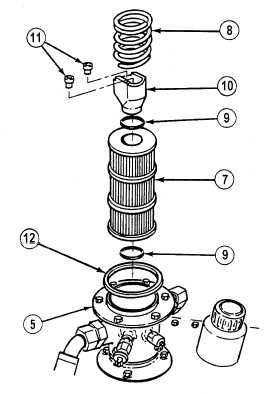|
| |
TM 9-2320-364-20-5
20-30
20-9. MAIN HYDRAULIC FILTER REPLACEMENT (CONT).
NOTE
Relief valve assembly pulls out
of filter.
(6)
Remove spring (8), two preformed
packings (9) and relief valve assembly (10)
from hydraulic filter (7). Discard filter and
preformed packings.
(7)
Remove two relief valves (11) from relief
valve assembly (10).
(8)
Remove and discard gasket (12) from filter
base (5).
b.
Cleaning/Inspection.
Drycleaning Solvent (P-D-680) is TOXIC and flammable. Wear protective goggles, face
shield, and gloves; use only in a well-ventilated area; avoid contact with skin, eyes, and
clothes, and do not breathe vapors. Keep away from heat or flame. Never smoke when using
solvent. The flashpoint for Type II Drycleaning Solvent is 140 degrees F (60 degrees C) and
Type III Drycleaning Solvent is 200 degrees F (93 degrees C). Failure to do so may result in
injury or death to personnel.
If personnel become dizzy while using cleaning solvent, immediately get fresh air and
medical help. If solvent contacts skin or clothes, flush with cold water. If solvent contacts
eyes, immediately flush eyes with water and get immediate medical attention.
(1)
Clean all metal parts with drycleaning solvent.
Compressed air used for cleaning purposes will not exceed 30 psi (207 kPa). Use only with
effective chip guarding and personal protective equipment (goggles/shield, gloves, etc).
Failure to comply may result in injury or death to personnel.
(2)
Dry metal parts with compressed air.
(3)
Inspect metal parts for breaks, cracks and sharp edges.
(4)
Manually operate relief valves and inspect for damage.
(5)
Replace all damaged parts.
|

